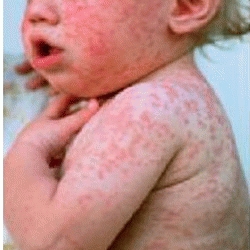1- Herpes:
– Herpes is the leading cause of recurrent erythema multiforme.
– Virus isolation with search cytopathic effect remains the reference method.
Serology is used for epidemiological purposes
– The ELISA test can distinguish between HSV1 and HSV2.
– Acyclovir is indicated for genital herpes (no marketing authorization for herpetic gingivostomatitis; nor for labial recurrences).
2- Measles:
– The invasion phase lasts 4 days: high fever, dry cough, nasal catarrh and eye with eyelid edema.
– The Koplik spots appear at the end of the period of invasion and persists for several days.
Pathognomonic but inconsistent.
– The rash starts behind the ears and extends from head to toe in a single push on 3-4 days;confluent rash trend but leaving healthy skin intervals; regresses in 4-5 days
– The vaccine provides effective immunity for more than 10 years; while the disease confers lasting immunity.
– Shareholders complications of measles virus are: bronchitis or bronchiolitis, a viral disease (giant cell interstitial pneumonia); acute encephalitis; SSPE (Von Bogart); stridulus laryngitis.
3- Rubella:
– Less contagious than measles (10% of women are not immune).
The infectious period extends from a week before the onset of the rash to 2 weeks.
– Constant lymphadenopathy; and predominate at the sub-occipital areas and retroauricular.
– The eruption extends 24 hours the first day and then morbilliform scarlatiniform 2nd j and disappears on the 3rd day.
– Fever (moderate) disappears at the onset of the rash
– The most common forms are persistent vegetative or asymptomatic
– The NFS shows leukoneutropenia and sometimes mononucléo-sic syndrome.
Other: thrombocytopenic purpura delayed (15 days after the eruption).
– Patent ductus arteriosus -> heart defect rubella.
4- Zona:
– Ophthalmic Zona: keratitis and iridocyclitis may appear 2-3 weeks after the end of the eruption.
– In immunocompetent patients: antiviral treatment is indicated in cases of ophthalmic zoster (preventing complications) and in subjects over 50 years (prevention of postherpetic neuralgia).
Treatment should be started within 72 hours. (In immunocompromised acyclovir should be administered IV).
In atopic subject (superinfection of eczema) antiviral treatment should be promptly undertaken to avoid pustulosis varioliformis’s sarcoma-Juliusberg.
5- NB:
– Changes in several pushed an eruption is seen in chickenpox and the Mediterranean spotted fever.
– There may be a reflex trismus during a mumps parotitis
– Cerebellar ataxia sometimes occurs in children; she still regresses without sequelae.





Leave a Reply